

Killing Animals at the Zoo. One afternoon last January, two years after staff members at the Copenhagen Zoo surprised many people by shooting a healthy young giraffe, dissecting it in public, and then feeding its remains to lions, another Danish zoo was preparing for a public dissection.
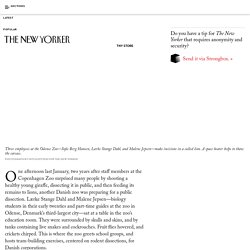
Why don't UPS drivers turn left? — Quartz. What does Donald Trump want for America?

His supporters don’t know. His party doesn’t know. Leaving Facebook... Explicit cookie consent. Otterly entrancing WHEN Australia’s prime minister came to visit Singapore last year, his local counterpart took him to visit not the Merlion, a statue of a mythical creature adopted decades ago as a national mascot, but the Bishan Ten—a photogenic family of otters that have become something of a national obsession.

In early August Singaporeans chose the Bishan Ten as the official emblem of their country’s 51st year. Frederick Law Olmsted and the Creation of Central Park. Singapore Is Taking the ‘Smart City’ to a Whole New Level. Edible six-pack rings feed animals instead of killing them - AOL. Aol.com Editors May 19th 2016 11:22AM.

India's dying mother. Germany had so much renewable energy on Sunday that it had to pay people to u... Elon Musk is building his dream factory in the Nevada desert.
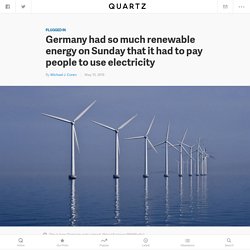
“I find this to be quite romantic,” he said during an interview session at the Gigafactory on Tuesday. “It feels like the Wild West.” Located 24 miles outside of Reno, the Gigafactory is slated to be the largest building in the world (by footprint) once it’s completed sometime in the future, measuring 5.9 million square feet, about the size of 107 football fields. It’s needed to house Tesla’s outsized ambitions to build the world’s largest, most efficient battery factory, delivering 35 gigawatt hours of lithium-ion batteries each year by 2018, more than total worldwide production just a few years ago. Why Our Young Architects Have Stopped Believing in Sustainability. In her hard-hitting, candid essay, Jaxe Pan examines the disillusionment faced by young architects dealing with the sustainable movement and how this reflects the state of the green industry at large.
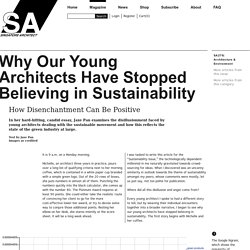
Text by Jaxe Pan Images as credited. Jane Jacobs believed cities should be fun — and changed urban planning forever. When Jane Jacobs published The Death and Life of Great American Cities in 1961, she was a lone voice with no credentials speaking up against the most powerful ideas in urban planning.

Fifty-five years later, on Jacobs's 100th birthday (honored in today's Google Doodle), urban dwellers are all living in her vision of the great American city. The Death and Life of Great American Cities was a reaction to urban planning movements that wanted to clear entire city blocks and rebuild them, believing beautiful architecture was superior to crowded streets.
Jacobs argued this ignored everything that made cities great: the mixture of shops, offices, and housing that brought people together to live their lives. And her vision triumphed. How Jacobs left her mark on urban planning. Lucius Riccio is the originator and chief proponent of pothole analytics. Tha... In like a lion, out like a—wham!
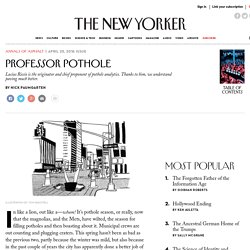
It’s pothole season, or really, now that the magnolias, and the Mets, have wilted, the season for filling potholes and then boasting about it. Municipal crews are out counting and plugging craters. This spring hasn’t been as bad as the previous two, partly because the winter was mild, but also because in the past couple of years the city has apparently done a better job of resurfacing the streets.
Growing New York’s underground park. Beneath Delancey Street on Manhattan’s Lower East Side lies a derelict tram station that’s been closed since 1948.
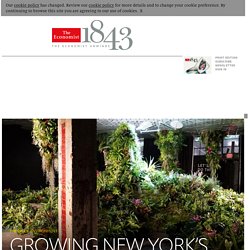
New York State Parks, After Years of Decline, Receive Infusion of Cash and Care. The silence of the deep: free-diving in Mozambique. How Orphaned Orangutans Messed With a Reporter’s Mind. Times Insider delivers behind-the-scenes insights into how news, features and opinion come together at The New York Times.
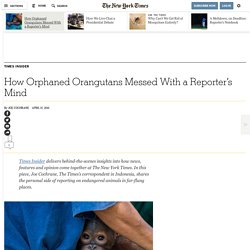
In this piece, Joe Cochrane, The Times’s correspondent in Indonesia, shares the personal side of reporting on endangered animals in far-flung places. Photo. Why America abandoned nuclear power (and what we can learn from South Korea) There's a simple, compelling argument that the world ought to be building many more nuclear power plants. We'll need vast amounts of carbon-free energy to stave off global warming. It's not at all clear that renewables can do the job alone. And nuclear is a proven technology, already providing 11 percent of electricity globally. So what's the catch? Cost, cost, cost. The Lawyer Who Became DuPont’s Worst Nightmare. What Just Happened to Solar and Wind is a Really Big Deal. The clean-energy boom is about to be transformed.
In a surprise move, U.S. lawmakers agreed to extend tax credits for solar and wind for another five years. This will give an unprecedented boost to the industry and change the course of deployment in the U.S. The extension will add an extra 20 gigawatts of solar power—more than every panel ever installed in the U.S. prior to 2015, according to Bloomberg New Energy Finance (BNEF). The U.S. was already one of the world's biggest clean-energy investors. This deal is like adding another America of solar power into the mix. The wind credit will contribute another 19 gigawatts over five years. How Solar and Wind Got So Cheap, So Fast. A funny change has happened this year: People have become tepidly optimistic about climate change.
That’s not because the UN climate negotiations currently underway in Paris look like they might succeed, or because the United States is finally getting serious about a clean-energy policy. And it’s not because humanity is any less likely to overshoot the 2-degree Celsius target that spells dangerous levels of global warming.
No, it’s because the two renewable-electricity-generating technologies that advocates hope will one day power much of human society—solar and wind—have both plunged in price in recent years. According to a recent report from Bloomberg New Energy Finance, on-shore wind is competitive with fossil-fuel-burning plants in many parts of the world. And if you factor in coal’s devastating public-health costs, it’s already much more expensive than solar or wind. These plunging costs are key to many popular assessments of global warming. Garbage in, garbage out.
Engineers and scientists will take on one of the world’s ugliest problems in 2016 as they test an ambitious method of cleaning the ocean of its tens of thousands of tonnes of floating plastic rubbish. The project is thoroughly unconventional. It was started by Boyan Slat, a teenage Dutch student, funded via Indiegogo, a crowdsourcing site, rather than by government grants—and at first criticised as impossible.
But in 2016 the Ocean Cleanup project is on track to build a 2km-long (1.2-mile) floating boom, claimed to be the longest structure the seas have ever seen, off the island of Tsushima in Japan. If it can remove floating junk cost-effectively, then planning will begin for a 100km structure capable of tackling the ocean’s most junk-ridden spots. Indonesia is burning. So why is the world looking away? I’ve often wondered how the media would respond when eco-apocalypse struck.
I pictured the news programmes producing brief, sensational reports, while failing to explain why it was happening or how it might be stopped. The Blood Harvest - Alexis C. Madrigal. The thing about the blood that everyone notices first: It's blue, baby blue. The marvelous thing about horseshoe crab blood, though, isn't the color. Catching up with China. EVERY so often a country comes along whose economic transformation has a vast impact on the world’s climate system.
For the past generation that country has been China. Next it will be India. Given India’s size and population (1.3 billion), its emissions of carbon dioxide are in relative terms still tiny. At 1.6 tonnes of carbon per person each year, they are roughly the same as China’s per-head emissions in 1980, when that country dived into economic reforms.
Now India’s prime minister, Narendra Modi, wants to emulate China’s sizzling growth. Government planners think that, with economic growth of 8-9%, India’s total emissions of carbon dioxide would more than triple by 2030, from 1.7 billion tonnes in 2010 to 5.3 billion tonnes.